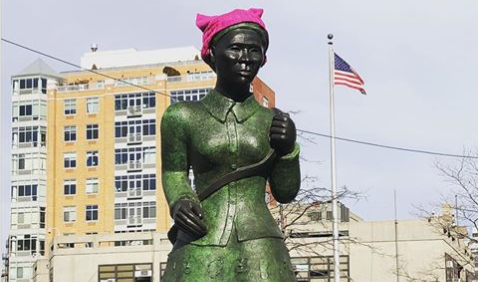
Mar
The Limits of Symbolic Design in Social Justice
[responsivevoice_button voice=”UK English Female” buttontext=”Listen to Post”]
As this country concludes yet another two months of symbolically acknowledging that Black people and women exist, I want to leave you with another thought. This past January marked the second National Women’s March, and another trotting out of the seemingly ubiquitous pink pussy hat. Someone had the damn nerve to put one on Harriet Tubman. I commend anyone who lifts the shame of a woman’s vagina. But here’s the tea: Harriet Tubman’s vagina would not have been all-pink!
There’s something too sanitized about an all-pink pussy. It’s too reductive and is afraid to admit that some women have darker vaginas. And that’s the downside in symbolic design. It’s non-threatening. It doesn’t demand enough. It could be co-opted into something more toothless. And, eventually, someone’s story gets unnecessarily lost.
”(Eddie Opara) said that when you're talking about design for social good, you're talking about political science. And when you're talking about that, you're now talking about policymaking.
The problem with symbolism is not that it’s meaningless. The problem with symbolic design as a tool for social justice is that we ask more of the symbol than it can carry. Yes, a mirrored coffin can act as a symbolic piece of art reflecting a significant political movement addressing years of police brutality against Black people, transwomen of color, and LGBT. But if transwomen are still getting killed by the police in the streets of St. Louis, and unarmed Black men are still being killed in the streets of D.C.,– the same city where that mirrored coffin is symbolically showcased at the National Museum of African American History and Culture — we have to ask ourselves if we’re asking too much of these symbols.
And political activists, not unlike other people, are too precious with their fixed symbols. Because if you change the symbol, you change what the symbol means. And that can be a good thing. But first, you have to ‘kill your darlings.’
Symbols can be designed to change.
And in some ways, symbolic design allows too many comfortable people off the hook. It keeps us from thinking deeper of own complicity. It gives us moral license to approve of or feign ignorance of systemic injustice.
”The problem with symbolism is not that it's meaningless. The problem with symbolic design as a tool for social justice is that we ask more of the symbol than it can carry.
Graphic designers like Paul Rand continue to teach modern design as reductivist and universal. These philosophies have been very instrumental in how we simplify a visual expression. But with new information, designers-as-practitioners don’t have to adopt this philosophy for everything we do. Take the pink pussy hat for example. I would love to redesign it by making it more inclusive. I can imagine starting at the base of the hat with a mix of brown skin tones that graduate to a soft pink. It would be more realistic and inclusive, but this solution runs the risk of excluding transwomen. For that, I would consult several transwomen designers. But even then, I understand its limits. It recognizes some women’s’ reproductive justice. And only symbolically.
As far as other symbols of social justice go, I don’t know. No one person has all the answers. But I do agree with Eddie Opara, Partner-in-Charge and Creative Director at Pentagram. He spoke at the REACH Conference and I asked what he thought about a growing number of designers interested in design as a social good. He said that when you’re talking about design for social good, you’re talking about political science. And when you’re talking about that, you’re now talking about policymaking.
”Symbols can be designed to change.
So our solutions may not come from our precious symbols and iconography, but from schools and institutions teaching design and political science and social science as a space for critical thinking, innovation, and public discourse. PoliSci majors can get into Graphic Design, Graphic Design Majors can get into PoliSci. That can’t be worn on the head or housed in a museum. And that’s fine. These symbols have value. They should be made with more nuance and forethought. They should change (e.g. rebranded) with new information.
But they can only do so much.



